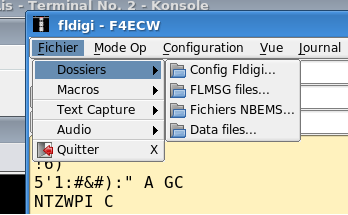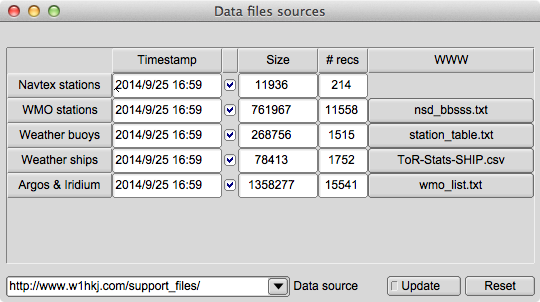Table of Contents
What is Synop
Weather data
SYNOP, which stands for surface synoptic observations is a numerical code used for reporting weather observations made by manned and automated fixed land weather stations. It is also called FM-12 by the
World Meteorological Organization. It is closely associated to FM 13-XIV SHIP, for report of surface observation from a sea station (Created in 1982) and FM 14-XIV SYNOP MOBIL, for reports of surface observation from a mobile land station.
Here is an example of undecoded SYNOP weather report:
13586 31530 80000 10036 20029 39821 40218 53002 71022 886//
333 20029 88715=
Many SYNOP reports are available on web sites such as Ogimet .
Synop reports broadcasts
The most important broadcaster on SYNOP data is DWD, in RTTY mode.
Deutsche Wetterdienst schedule
SYNOP reports are typically sent every six hours by Deutscher Wetterdienst on shortwave and low frequency using RTTY.
The baud rate must be 50 bauds.
| Freq | Station | Time | |
|---|---|---|---|
| 147,300 kHz | DDH47 | 05.00 - 22.00 | + / - 42,5 |
| 4583,000 kHz | DDK2 | 00.00 - 24.00 | + / - 225,0 |
| 7646,000 kHz | DDH7 | 00.00 - 24.00 | + / - 225,0 |
| 10100,800 kHz | DDK9 | 00.00 - 24.00 | + / - 225,0 |
| 11039,000 kHz | DDH9 | 05.00 - 22.00 | + / - 225,0 |
| 14467,300 kHz | DDH8 | 05.00 - 22.00 | + / - 225,0 |
Other broadcasters
Until recently, many shore stations used to transmit Synop reports by Morse Code ("Ocean Yacht Navigator", Kenneth Wilkes, 1976 ). Still, according to WMO information for shipping, a couple of maritime stations might broadcast these informations in different mode that RTTY, but this has not been tested yet. There are just anecdotically cited here.
Maritime Radio Station of Mumbai
Met codes: FM 12 - SYNOP, FM 13 - SHIP for Sea areas I.
| Band | Freq |
|---|---|
| WT (MF) | 500 kHz |
| WT (MF) | 521 kHz |
| WT (HF) | 8630 kHz |
| WT (HF) | 12710 kHz |
SYNOP decoding is not accessible fromMorse CW modem yet.
Navtex station of Mumbai. COMCEN
FM 12 SYNOPSIS, FM 13 SHIP for sea area I (Time schedule 0900, 2100)
| Freq | |
|---|---|
| Navtex (Also called MSI as Maritime Safety Information) | 518 kHz |
SYNOP decoding is not accessible from Navtex modem yet.
Marine Rescue Co-ordination Centre: Guayaquil, Radio IOA (Instituto Oceanografico Armada) o Radio Naval
Meteorological information in process: Text, SHIP, SYNOP.
| Mode | Freq |
|---|---|
| AM | 1515 kHz |
Parameters

By default, there is not SYNOP decoding of RTTY reception, so its behavior does not change. However, it receives three new parameters related to Synop decoding.
SYNOP reports can be saved to the current ADIF log file: They are visible in the journal of QSOs with the content of the report, the timestamp, and the Maidenhead locator equivalent to the geographical coordinates of the emitter of the report.
SYNOP weather reports can also be plotted on KML files: They can then be visualized in KML viewers such as Google Earth.
If SYNOP reports are saved either to ADIF or KML files, fldigi attempts to detect and decode RTTY messages. When these messages are detected, they are displayed in the reception window. An extra parameter allows to replace the coded Synop message, giving clarity at the risk of loosing information, or mix the decoded reports with the original group of digits (Interleaving of SYNOP and text).
Reception window
When SYNOP messages are detected, they are displayed in the reception window in "red" characters (depicted here in "italic"). Here are some examples (Interleaved text and SYNOP reports):
13661 16123 99276 70216 46///
WMO Station=13661
WMO station=WMO_13661
UTC observation time=2013-02-16 12:00
QLLLL token=Present
Longitude=-21.6
Latitude=27.6
/// 40206 52011
222// 00203;
Sea surface temperature=20.3 –C
Temperature type=Intake measurement
64522 16123 99591 70347 46///
WMO Station=64522
WMO station=WMO_64522
UTC observation time=2013-02-16 12:00
QLLLL token=Present
Longitude=-34.7
Latitude=59.1
/./ 49920 57004.
::(1056;
, 26555 16123 998#6
WMO Station=26555
WMO station=WMO_26555
UTC observation time=2013-02-16 12:00
70269 46/// ///// 40168 52008;
WMO Station=70269
WMO station=WMO_70269
Precipitations=Omitted, no observation
Station type=Automated station. No observation (No 7WW)
Visibility=Missing
Wind direction=No motion or no waves
Wind speed=0 knots (Estimated)
Sea level pressure=1016 hPa
Pressure tendency=Increasing steadily. Raises
Pressure change=0.8 hPa
25617 16123 99867 1173!((6;
WMO Station=25617
WMO station=WMO_25617
UTC observation time=2013-02-16 12:00
QLLLL token=Present
149 52001;
13660 16123 992!;
WMO Station=13660
WMO station=WMO_13660
UTC observation time=2013-02-16 12:00
).'/ ///// 40222 52&17
52"// 08)02;
44551 16123 99376 70378 46//.
WMO Station=44551
WMO station=WMO_44551
UTC observation time=2013-02-16 12:00
QLLLL token=Present
Longitude=-37.8
Latitude=37.6
/// 40185 52022;
Sea level pressure=1018 hPa
Pressure tendency=Increasing steadily. Raises
Pressure change=2.2 hPa
62680 16123
9958"
WMO Station=62680
WMO station=Atbara
UTC observation time=2013-02-16 12:00
70265 66//? BMPROIIO TUPEQ
222!/ 00078;
64527 16123 99593 70483 46///
WMO Station=64527
WMO station=WMO_64527
UTC observation time=2013-02-16 12:00
QLLLL token=Present
Longitude=-48.3
Latitude=59.3
/// 40095 52004
Data files
Several data files containing public information are used to decrypt SYNOP data. They come from various places on the Internet, with redundancy.
| NOAA | WMO identifier, name and coordinates of thousands of weather stations in the world. |
| http://weather.noaa.gov/data/nsd_bbsss.txt | |
| NOAA | Weather, drifting, moored and wave riders buoys. Oil platforms. Fixed and mobile offshore drilling unit. |
| ftp://tgftp.nws.noaa.gov/data/observations/marine/stations/station_table.txt | |
| UK's National Weather Service | Name, country and description of weather ships |
| http://www.metoffice.gov.uk/media/csv/e/7/ToR-Stats-SHIP.csv | |
| Joint WMO IOC Technical Commission for Oceanography and Marine Meteorology | Argos and Iridium buoys, with WMO identifiers. |
| ftp://ftp.jcommops.org/JCOMMOPS/GTS/wmo/wmo_list.txt | |
There is a specific window for downloading the latest version of these data files. It can be reached with the command "File/Folders":

These data files can also be found:
- At installation time your fldigi binary comes with a package. All data files are silently installed on your machine.
- When building your own binary from the sources, with the command make install. Similarly, all files are installed.
- At first use and automatic installation, this opens the Data files sources menus, where you can download all or some data files used by fldigi.

Outputs
Each message is a set of key-value pairs, associated to:
| Description | Measurement |
|---|---|
| Wind direction | 315 degrees |
| Wind speed | 8 m/s (Anemometer) |
| Temperature | 0.0 deg C |
| Dew point temperature | -3.8 deg C |
| Station pressure | 1006 hPa |
| Sea level pressure | 1030 hPa |
Output formats
ADIF
When the option is ticked, SYNOP weather reports are saved in a new ADIF record, in the default logfile.
The report itself is saved with field <NOTES:xx>. The length can be of several hundredth of chars, and accordingly to the ADIF standard, new-lines can appear in each report.
Example of <NOTES> field in an ADIF record:
Header ICAO indicator=LOWM Identification and location Land station observation Land observations Precipitations=Precipitation omitted, no precipitation Station type=Manned station. 7WW omitted, not significant Cloud base=600 to 1000 m Visibility=15 km Cloud cover=7/8
KML
SYNOP reports can generate KML files for fixed stations, mobile weather ships, buoys etc... that is, every observation which can be associated to a set of coordinates. Several reports of the same station can be aggregated in a single place mark. Mobile stations have their path drawn, linking all coordinates spotted for a given station with an unique name.
KML data are are also saved in a display-independent format in <description> tags, and thus can easily be reused by other software.
Command-line SYNOP decoder program : synop_tool
The decoder comes with synop_tool, a command-line tool able to decode input text files and generate the same output files as fldigi. It is intended as a development for checking internal consistency, and accuracy of SYNOP decoding without the complexity of the graphical interface.
It is accessible in the directory fldigi/src/synop-src and must be built with the command make.
Its command-line options are displayed with the option –help:
[fldigi/src/synop-src]$ ./synop_tool --help
Valid options are:
data_dir # Where the data files are stored. For example /usr/local/share/fldigi/
kml_dir # Out put directory of created KML files.
load_dir # Input directory of KML files loaded at startup.
dbg # Verbose mode.
usage # Print this message.
test # Decoding preceded by an internal test.
matrix # KML output in aggregated matrices (See KML documentation).
regex # text output of regular expressions, not decoded reports.
version # Prints version number.
help # Prints this messages